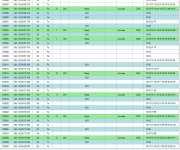TheWaterboy
Lifetime Supporting Member + Moderator
I have been fighting with a series of GE MDS orbit MCR radios and DF1 Hdx comms (PLC5's) over low bandwidth (220mhz). This battle has been going on for 2 years. Ethernet comms seems to work well enough but DF1 traffic has a 50% success rate at BEST. End of life Esteem radios have been doing this job for a decade with far less trouble and still do at a 450 mhz freq. I would have stuck with them if they had the lower bandwidth I need for terrain conditions and the rules that allow voice to override SCADA data in the 450 band. But they didn't.
I need to hire a consultant to help me diagnose and fix this. I have exhausted everyone nearby... my usual integrator, GE support and the dealer that sold them to me. They all either are out of ideas or run away when they find its DF1.
I have one location that has both Ethernet and a KE module. If I use the ethernet channel it works 100% of the time, if I switch to DF1, its a 80% failure. Not 100%, 80%. So I have my addressing and setting correct.
I can also SSH into these and that is slow, but stable. That tells me the RF conditions are fine, its the protocol, perhaps combined with the low bandwidth, that causes a problem with timing in this radio.
I am willing to talk to anyone who has had good success in this space or someone that has determined it will never work because GE doesn't care if it does.
I need to hire a consultant to help me diagnose and fix this. I have exhausted everyone nearby... my usual integrator, GE support and the dealer that sold them to me. They all either are out of ideas or run away when they find its DF1.
I have one location that has both Ethernet and a KE module. If I use the ethernet channel it works 100% of the time, if I switch to DF1, its a 80% failure. Not 100%, 80%. So I have my addressing and setting correct.
I can also SSH into these and that is slow, but stable. That tells me the RF conditions are fine, its the protocol, perhaps combined with the low bandwidth, that causes a problem with timing in this radio.
I am willing to talk to anyone who has had good success in this space or someone that has determined it will never work because GE doesn't care if it does.




